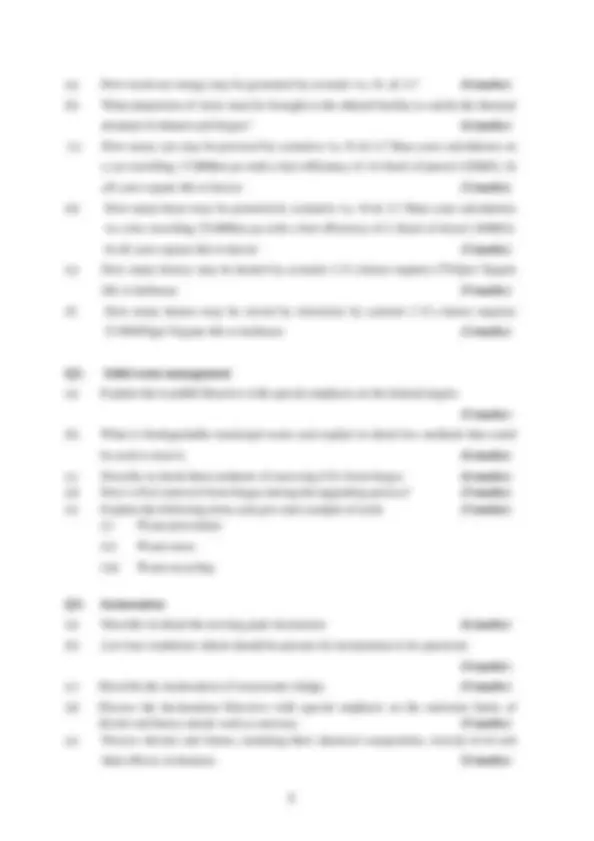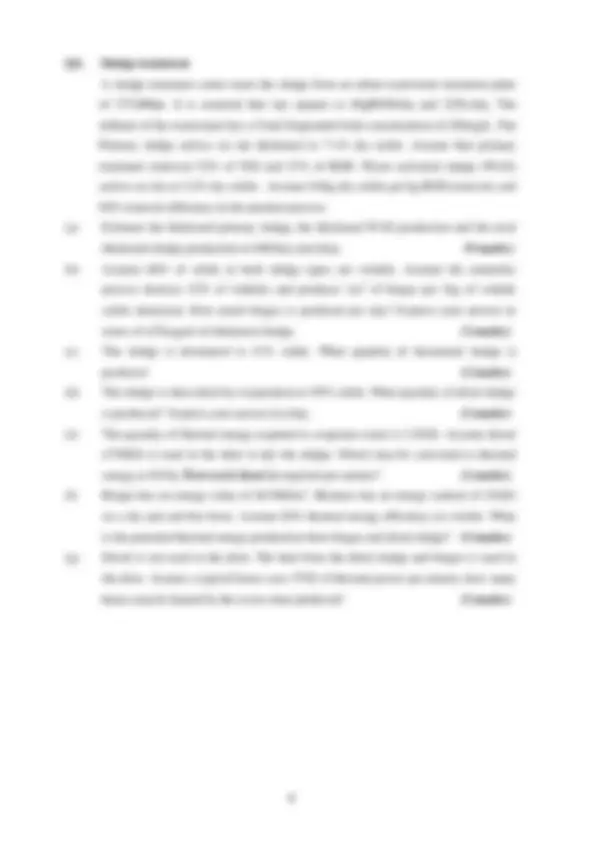




Study with the several resources on Docsity

Earn points by helping other students or get them with a premium plan


Prepare for your exams
Study with the several resources on Docsity

Earn points to download
Earn points by helping other students or get them with a premium plan
Community
Ask the community for help and clear up your study doubts
Discover the best universities in your country according to Docsity users
Free resources
Download our free guides on studying techniques, anxiety management strategies, and thesis advice from Docsity tutors
The instructions and questions for the semester 2 examinations 2011/12 of the environmental and energy engineering module at the cork institute of technology. Topics such as biofuels production, solid waste management, and incineration. Students are required to answer questions related to the energy value, parasitic thermal demand, and net energy generation of different biofuels scenarios, as well as the treatment and disposal of biogas and solid waste.
Typology: Exams
1 / 4

This page cannot be seen from the preview
Don't miss anything!



Semester 2 Examinations 2011/
Module Code: CIVL
School: Department of Civil, Strutural and Environmental Engineering
Programme Title: Bachelor of Engineering (Hons) in Structural Engineering – Year 4 Bachelor of Engineering (Hons) in Sustainable Energy Technology – Year 4 Certificate in Environmnetal & Energy Engineering – Year 1
Programme Code: CSTRU_8_Y ESENT_8_Y EENEN_8_Y
External Examiner(s): Dr M. Richardson, Mr J. O’Mahony Internal Examiner(s): Dr N. Power
Instructions: Answer all question
Duration: 2 Hours
Sitting: Autumn 2012
Requirements for this examination:
Note to Candidates: Please check the Programme Title and the Module Title to ensure that you have received the correct examination paper. If in doubt please contact an Invigilator.
Q1. Biofuels A total of 45,000ha of land will be made available for energy crop production. Currently three transport fuel scenarios and one thermal energy scenario is being considered.
Scenario 1: Transport Fuel: Three transport fuel scenarios are being considered. Pure plant oil has an energy value of 36GJ/t, ethanol has an energy value of 21MJ/l, and biogas has an energy value of 20.5MJ/m^3. However the parasitic thermal demand for ethanol, biogas and PPO are 7.6MJ/l, 3.5MJ/m^3 and 5.1GJ/t respectively. It is proposed to burn straw to satisfy the parasitic thermal demand of ethanol & biogas, and to import the parasitic demand for PPO from renewable sources. Typically 4.7t of straw are generated per hectare of cereals per annum.
Scenario 1a: Ethanol Scenario 1b: Biogas Scenario 1c: PPO 15,000ha under sugarbeet 15,000ha under sugarbeet 45,000ha under rapeseed 15,000ha under wheat 15,000ha under wheat 15,000ha under barley 15,000ha under barley Crop Crop (t/ha)
Fuel Ethanol/PPO Biogas Sugarbeet 44 101 l ethanol / t 130 m^3 /t Wheat 8.7 370 l ethanol / t 400 m^3 /t Barley 6.7 330 l ethanol / t 325 m^3 /t Rapeseed 3.6 0.35t oil /t Energy from straw Straw has a moisture content of 18%; and 13% of solids are ash Straw has an energy value of 21GJ/t on a dry and ash free basis Latent heat of evaporation at partial pressure of vapour is 2500kJ/kg of water Lower Heating Value (LHV) = Higher Heating Value (HHV) – latent heat of evaporation Boiler converts straw to thermal energy at 86% efficiency
Scenario 2: CHP system 45,000ha of miscanthus is to be grown on the land. The miscanthus will be harvested, processed and pelletted and utilised in a CHP system.
Energy from miscanthus Miscanthus yields 16t/ha at a moisture content of 20% Miscanthus has an energy value of 17.9GJ/tds Latent heat of evaporation at partial pressure of vapour is 2500kJ/kg of water Lower Heating Value (LHV) = Higher Heating Value (HHV) – latent heat of evaporation CHP converts miscanthus at a thermal efficiency of 37% and electrical efficiency of 31%
Q4. Sludge treatment A sludge treatment centre treats the sludge from an urban wastewater treatment plant of 375,000pe. It is assumed that 1pe equates to 60gBOD/day and 225L/day. The influent of the wastewater has a Total Suspended Sold concentration of 250mg/L. The Primary sludge arrives on site thickened to 7.1% dry solids. Assume that primary treatment removed 52% of TSS and 27% of BOD. Waste activated sludge (WAS) arrives on site at 3.2% dry solids. Assume 0.6kg dry solids per kg BOD removed, and 94% removal efficiency in the aeration process. (a) Estimate the thickened primary sludge, the thickened WAS production and the total thickened sludge production in tDS/day and t/day. (9 marks) (b) Assume 68% of solids in both sludge types are volatile. Assume the anaerobic process destroys 53% of volatiles and produces 1m^3 of biogas per 1kg of volatile solids destroyed. How much biogas is produced per day? Express your answer in terms of m^3 biogas/t of thickened sludge. (3 marks) (c) The sludge is dewatered to 31% solids. What quantity of dewatered sludge is produced (2 marks) (d) The sludge is then dried by evaporation to 95% solids. What quantity of dried sludge is produced? Express your answer in t/day. (2 marks) (e) The quantity of thermal energy required to evaporate water is 2.5GJ/t. Assume diesel (37MJ/l) is used in the drier to dry the sludge. Diesel may be converted to thermal energy at 82%η. How much diesel is required per annum? (2 marks) (f) Biogas has an energy value of 20.5MJ/m^3. Biomass has an energy content of 21GJ/t on a dry and ash free basis. Assume 84% thermal energy efficiency in a boiler. What is the potential thermal energy production from biogas and dried sludge? (5 marks) (g) Diesel is not used in the drier. The heat from the dried sludge and biogas is used in the drier. Assume a typical house uses 57GJ of thermal power per annum, how many house may be heated by the excess heat produced? (2 marks)